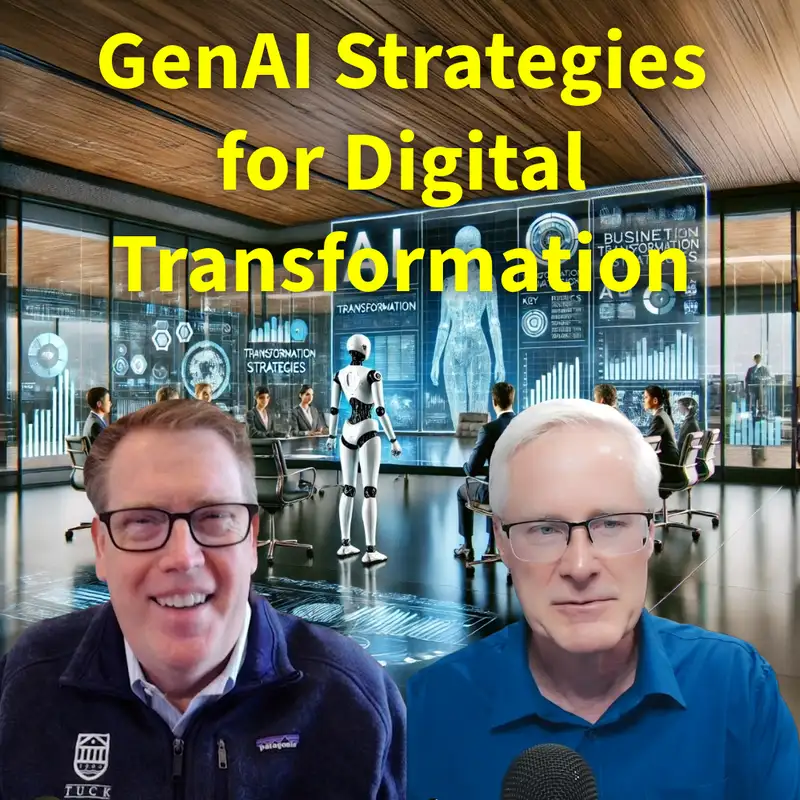#251 GenAI in Digital Transformation: Strategies for Success
Dr Darren and George Stelling discuss the transformative role of AI in business, exploring George's extensive background in digital transformation and his current work with Quadrillion Partners. They delve into the challenges and strategies of implementing successful digital transformations, key metrics' importance, and generative AI's impact on business processes. George shares insights on managing expectations, addressing security concerns, and the evolving landscape of AI technology. ## Takeaways * AI is a disruptive force in business, similar to political disruptions. * A significant percentage of digital transformations fail, but Quadrillion * * Partners boasts a much higher success rate. * Key metrics like EBITDA and revenue growth are crucial for measuring * transformation success. * Digital transformation requires a structured approach, akin to building a house. * AI should be viewed as a tool within a broader transformation strategy, not a standalone solution. * Human intervention remains essential in AI implementations. * Understanding the costs associated with AI, especially large language models, is critical. * Education and demystification of AI technology are necessary for executive buy-in. * Focusing on a few impactful initiatives is more effective than spreading resources too thin. * The architecture of AI solutions is evolving, necessitating careful planning and integration.
In today's fast-paced business environment, digital transformation is not just an option; it's a necessity. As organizations embrace new technologies and methodologies, a staggering percentage, about 70%, are reported to fail in their digital transformation efforts. However, if executed correctly, the success rate can soar to 90%. Understanding the factors driving successful transformations is crucial for technologists and business leaders. In this blog, we’ll explore critical strategies and insights that can lead organizations toward successful digital transformation initiatives, particularly in the context of leveraging artificial intelligence (AI).
The Importance of Strategic Planning
Digital transformation begins with thorough and strategic planning. A clear roadmap not only guides organizations through the transformation process but also defines success. Establishing Key Performance Indicators (KPIs) is essential—it helps measure success and align stakeholders toward common goals. Though it may be tempting to jump straight into implementation, taking time upfront to identify key metrics can have a lasting impact on transforming operations. Expect to revisit these KPIs regularly to assess progress and ensure they align with business objectives.
Furthermore, engaging all levels of the organization is fundamental during the planning phase. The insights from those on the front lines can provide invaluable perspectives on where bottlenecks exist and how processes can be optimized. By incorporating feedback from various teams, organizations can better identify which aspects of their operations are ripe for transformation. It’s not merely about adopting new technology but integrating it thoughtfully into existing processes to drive tangible value and enhance overall business performance, with AI playing a significant role in this enhancement.
Embracing AI: From Buzzword to Game Changer
Artificial Intelligence exists at the forefront of digital transformation, yet many organizations face confusion and apprehension regarding its integration. It's essential to approach AI strategy as just one part of a broader transformation initiative. While many executives rush toward the latest AI solutions, it's critical to remember that the technology is not a panacea. Companies must assess their applicability. It's crucial to note that on a case-by-case basis, ensuring that the implemented AI solutions add value and align with the organization’s strategic goals.
Companies should begin by identifying specific pain points where AI can significantly impact them, such as automating repetitive tasks or enhancing data analytics capabilities. For instance, implementing AI-driven chatbots has proven to reduce costs and improve customer service speeds, illustrating a compelling use case. However, it is vital not to overlook the potential complexities and costs of deploying AI solutions. Businesses should explore how AI can integrate with existing workflows while preparing for associated expenses, such as cloud computing or data privacy considerations.
Continuous Measurement and Adaptation
Implementing a digital transformation strategy is not a one-time effort; it requires ongoing measurement and adaptation. Organizations should establish KPIs at the onset and build regular checkpoints to assess progress against these metrics. By committing to a continuous feedback loop, businesses can stay agile and responsive to any emerging challenges as they achieve their transformation goals, highlighting the necessity of agility in the digital transformation journey.
The market is continually evolving, and so are the technological tools that drive digital transformation. For example, organizations might need to pivot due to changes in market conditions, such as fluctuations in interest rates or shifts in consumer behavior. This flexibility allows businesses to scale back initiatives that may no longer be viable or invest in new opportunities that emerge—ensuring the organization remains relevant and competitive.
As organizations journey through their digital transformation efforts, cultivating a culture of adaptability is essential. Encouraging teams to experiment with new tools or processes allows them to explore innovative solutions tailored to their needs. This environment of experimentation can ultimately lead to the discovery of novel applications that enhance the organization's efficiency and effectiveness. A adaptability culture is beneficial and essential in the digital transformation journey.
A Call to Action
Digital transformation is undoubtedly a complex, multifaceted journey. Organizations must take a balanced approach that combines careful planning, informed use of AI, continuous measurement, and a culture of agility to successfully navigate this challenging landscape. Remember, the transformation should aim for operational efficiency and strive to enhance the overall customer experience.
As you embark on your digital transformation journey, consider implementing these strategies and leveraging AI thoughtfully to drive measurable results. Explore additional resources and case studies in the digital transformation domain to learn more about these strategies and best practices. Your journey towards embracing digital transformation begins now—act decisively to capitalize on the opportunities.

